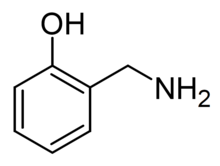2-Hydroxybenzylamine (2-HOBA, marketed as Hobamine) is a natural product found in Himalayan tartary buckwheat (Fagopyrum tataricum). It acts as an antioxidant and scavanger of free radicals and isolevuglandins and is sold as a dietary supplement.[1][2][3][4]
 | |
| Identifiers | |
|---|---|
| |
| CAS Number | |
| PubChem CID | |
| UNII | |
| ECHA InfoCard | 100.012.045 |
| Chemical and physical data | |
| Formula | C7H9NO |
| Molar mass | 123.155 g·mol−1 |
| 3D model (JSmol) | |
| |
| |
References
edit- ^ Fuller JC, Pitchford LM, Morrison RD, Daniels JS, Flynn CR, Abumrad NN, Oates JA, Boutaud O, Rathmacher JA (November 2018). "In vitro safety pharmacology evaluation of 2-hydroxybenzylamine acetate". Food and Chemical Toxicology. 121: 541–548. doi:10.1016/j.fct.2018.09.047. PMC 6220894. PMID 30253245.
- ^ Tao H, Huang J, Yancey PG, Yermalitsky V, Blakemore JL, Zhang Y, et al. (August 2020). "Scavenging of reactive dicarbonyls with 2-hydroxybenzylamine reduces atherosclerosis in hypercholesterolemic Ldlr-/- mice". Nature Communications. 11 (1): 4084. Bibcode:2020NatCo..11.4084T. doi:10.1038/s41467-020-17915-w. PMC 7429830. PMID 32796843.
- ^ May-Zhang LS, Kirabo A, Huang J, Linton MF, Davies SS, Murray KT (January 2021). "Scavenging Reactive Lipids to Prevent Oxidative Injury". Annual Review of Pharmacology and Toxicology. 61: 291–308. doi:10.1146/annurev-pharmtox-031620-035348. PMID 32997599. S2CID 222170646.
- ^ O'Neill MJ, Yoneda ZT, Crawford DM, Ye F, Ao M, Pitchford LM, et al. (August 2021). "2-Hydroxybenzylamine (2-HOBA) to prevent early recurrence of atrial fibrillation after catheter ablation: protocol for a randomized controlled trial including detection of AF using a wearable device". Trials. 22 (1): 576. doi:10.1186/s13063-021-05553-6. PMC 8403349. PMID 34454591.